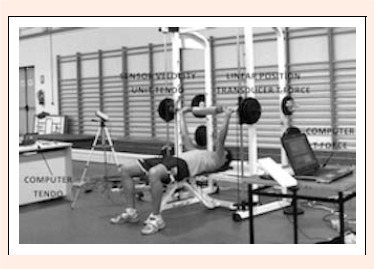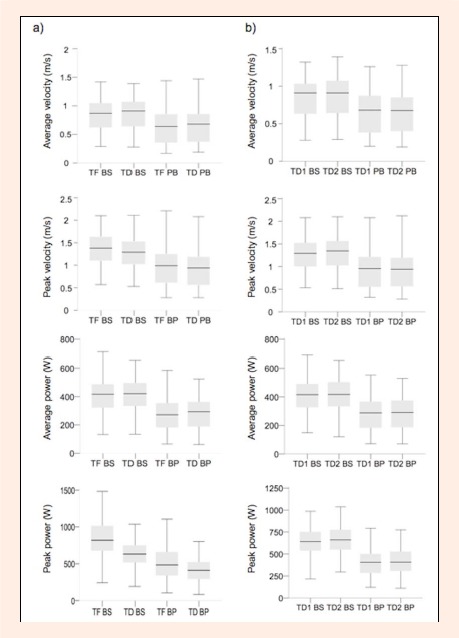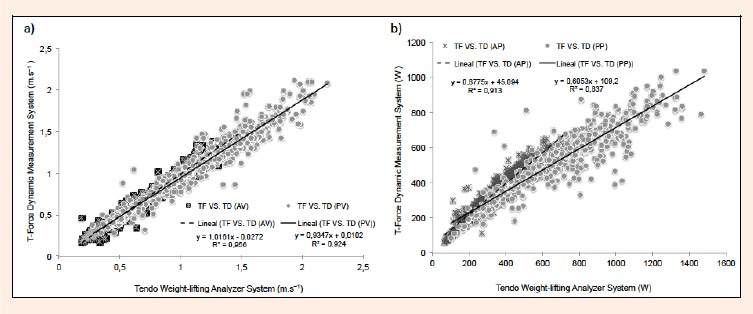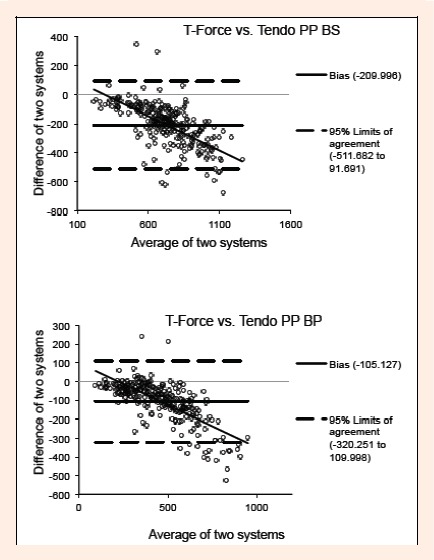Abstract
The objectives of the study were to determine the validity and reliability of peak velocity (PV), average velocity (AV), peak power (PP) and average power (AP) measurements were made using a linear position transducer. Validity was assessed by comparing measurements simultaneously obtained using the Tendo Weightlifting Analyzer Systemi and T-Force Dynamic Measurement Systemr (Ergotech, Murcia, Spain) during two resistance exercises, bench press (BP) and full back squat (BS), performed by 71 trained male subjects. For the reliability study, a further 32 men completed both lifts using the Tendo Weightlifting Analyzer Systemz in two identical testing sessions one week apart (session 1 vs. session 2). Intraclass correlation coefficients (ICCs) indicating the validity of the Tendo Weightlifting Analyzer Systemi were high, with values ranging from 0.853 to 0.989. Systematic biases and random errors were low to moderate for almost all variables, being higher in the case of PP (bias ±157.56 W; error ±131.84 W). Proportional biases were identified for almost all variables. Test-retest reliability was strong with ICCs ranging from 0.922 to 0.988. Reliability results also showed minimal systematic biases and random errors, which were only significant for PP (bias -19.19 W; error ±67.57 W). Only PV recorded in the BS showed no significant proportional bias. The Tendo Weightlifting Analyzer Systemi emerged as a reliable system for measuring movement velocity and estimating power in resistance exercises. The low biases and random errors observed here (mainly AV, AP) make this device a useful tool for monitoring resistance training.
Key points.
This study determined the validity and reliability of peak velocity, average velocity, peak power and average power measurements made using a linear position transducer
The Tendo Weight-lifting Analyzer Systemi emerged as a reliable system for measuring movement velocity and power.
Key words: Back squat, bench press, concentric phase, weight training exercises
Introduction
Validity, precision and reliability in power, strength and movement velocity measurements are essential for assessing performance in many sport disciplines. The main variables traditionally considered in strength training for stimulus control have been the type and order of exercises, the number of sets and repetitions, the workload or training intensity and the recovery time (Kraemer and Ratamess, 2004). Movement velocity is another factor that may be useful for assessing and monitoring resistance training (Izquierdo et al., 2006; Pereira and Gomes, 2003) characterizing the type of neuromuscular response and the subsequent adaptations. The use of workloads providing different levels of resistance (light, medium or heavy) will affect movement velocity (high, moderate or low, respectively) (Sánchez-Medina and González-Badillo, 2011) and by varying this velocity power levels could be improved (McBride et al., 2002). For example, light and medium load intensities are best at increasing average power (Baker et al., 2001; Cronin and Sleivert, 2005). Some studies have shown minimal changes in peak power across a spectrum of loads (Kawamori et al., 2005; Kilduff et al., 2007). In addition, heavy loads do not seem suitable to optimize power levels in exercise like bench press (BP) and bench pull (Sánchez-Medina et al., 2013), although they have been shown to improve peak force (Kawamori et al., 2005), power levels and rate of force development in Oympic lifts and their derivatives exercises (i.e., mid-thigh clean pull, back squat) (Comfort et al. 2012; Cormie et al., 2011). These variations demonstrate that force and power levels depend on the type of exercise.
The direct acquisition of this kinetic data requires the use of a force platform. Considered as the “gold standard” for measuring variables associated with strength and power (Nigg and Herzog, 1994), this method is not always practical and cost-effective, and generally limited to laboratory-based settings (Walsh et al., 2006). However, other kinematic systems like the linear position transducer are becoming popular tools for estimating power output, strength and movement velocity in resistance exercises (Cormie et al., 2007a; 2007b; Hori et al., 2007). Linear transducers use a cord attached to a subject or equipment to obtain displacement, movement velocity and acceleration data. These data are then used to estimate strength and power when the mass of the load and/or subject are taken into account. Several studies (Cronin et al., 2004; Drinkwater et al., 2007) have demonstrated the validity of this system for estimating strength and power (r = 0.86-1.00).
Recently, linear position transducer systems like the Tendo FiTROdyne and the Tendo Weightlifting Analyzer Systeml (TWAS) (TENDO Sports Machines; Trencin, Slovak Republic), have been used to assess peak power (Jones et al., 2008). Other studies have revealed their moderate to high test-retest reliability when measuring peak power and peak movement velocity using different loads in various exercises (back squat, bench press and free weight biceps curl) (Jennings et al., 2005; Stock et al., 2011).
The aim of this study was to assess the validity and reliability of the TWAS to measure movement velocity and power (average and peak) in full back squat and bench press exercises. We speculated that the results of both studies (validity and reliability) would show strong correlation, and that average values obtained using the TWAS would not differ from those of the criterion instrument (validity). Further, we expect similar average values between both testing sessions, indicating a high reliability of the TWAS in all the tests. The presence of systematic and proportional biases for the different variables studied was also addressed.
Methods
Subjects
The study protocol was approved by the Review Board of the Department of Physical Activity and Sports Science (Universidad Alfonso X El Sabio, Madrid, Spain). Procedures were in accordance with ethical standards (Harriss and Atkinson, 2011). Seventy-one men (age: 21.6 ± 2.1 years; weight: 71.9 ± 10.7 kg; height: 1.76 ± 0.08 m) volunteered to participate in the validity study and 32 male volunteers (age: 20.7 ± 3.4 years; weight: 76.3 ± 8.5 kg; height: 1.72 ± 0.05 m) were recruited for the reliability study. All participants were healthy students from the Faculty of Physical Activity and Sports Science that engaged in physical activity at least three times per week and were experienced in weight training (bodybuilding and recreation) (years of experience: 3.2 ± 1.72). Participants were informed of the experimental procedures and purpose of the study and signed an informed consent document before the commencement of testing. Furthermore, participants were asked to refrain from strenuous physical effort 48 hours before each testing session. All tests were carried out at the same time and under similar environmental conditions (21°C–24°C and 60%–70% humidity).
Procedures
Validity was assessed by comparing measurements simultaneously obtained using the TWAS and T-Force Dynamic Measurement System (TFDMS) during two resistance exercises BP and full BS. The reliability of the TWAS was assessed by comparing measurements made in 2 different sessions 1 week apart
Both studies followed the same protocol for measuring movement velocity and power. Two days before the test was carried out, subjects performed a short practice test consisting of a few exercise sets using light and medium loads. As the subjects were experienced, only two practice sessions were completed to avoid learning effects. The protocols followed similar guidelines to those prescribed by Maté et al. (2014). On the test day, participants performed a general warm up followed by a specific warm up (Table 1) to become familiar with the lift being performed. The warm-up consisted of 5 minutes of gentle running and 5 minutes of stretching and joint mobility exercises of the upper and lower extremities. Three exercise sets were performed: the first consisted of 8 repetitions of bar exercises at a moderate execution speed, the second of 6 repetitions lifting a 20 kg load at sub-maximal speed and the third of 4 repetitions lifting a 30 kg load at maximal speed. The recovery time between each set was always 1 minute. After a rest period of 3 min, participants initiated the protocol for measuring movement velocity and power in the BS. It consisted of 4 sets: 4 repetitions lifting a 40 kg load, 3 repetitions lifting a 50 kg load, 2 repetitions lifting a 60 kg load and, finally, a set in which subjects performed as many repetitions as possible using a load of 85% relative to the one repetition maximum (1RM), or maximal strength (estimated in the previous set according to the movement velocity obtained with the T-Force Dynamic Measurement SystemF) (Sánchez-Medina et al., 2010). If 5 to 6 repetitions were carried out, the 85% of 1RM was taken as valid given the direct relationship between the number of repetitions that can be executed at 85% and 1RM (Baechle and Earle, 2008).
Table 1.
Test session protocol
| Specific Warm up | BS protocol | BP protocol | |||
|---|---|---|---|---|---|
| Rep. X Load | RT | Rep. X Load | RT | Rep. X Load | RT |
| 8 x bar | 1 | 4 x 40 Kg | 3 | 4 x 40 Kg | 3 |
| 6 x 20 kg | 1 | 3 x 50 kg | 3 | 3 x 50 kg | 3 |
| 4 x 30 kg | 3 | 2 x 60 kg | 3 | 2 x 60 kg | 3 |
| 1 x 85% 1MR | 5 | 1 x 85% 1MR | 5 | ||
Rep.= Repetitions; RT = Recovery Time (minutes); BS = Back Squat; BP = Bench Pres
Three minutes of recovery time was allowed between each set of repetitions. After finishing the BS protocol, there was a 5 min rest period and then, participants started with the BP session. The protocol followed was exactly the same as that described for BS using the same loads, sets, repetitions and recovery times. Participants were asked to perform each repetition at the maximum speed possible. This experimental design aimed to apply a variety of stimuli with low, moderate and high resistances to prompt different movement velocities (high, moderate and low) and, consequently, unequal power levels, providing us with a varied, complete and appropriate comparative data for both studies.
Exercise techniques
Researchers placed emphasis on adequate standard technical execution (Baechle and Earle, 2008). For the BP exercise, participants laid flat on their backs on a bench with feet on the ground and hands on the bar in a pronated grip, a little wider apart than the width of the shoulders (4-8 cm). When instructed by the observer, the subject commenced the movement using the corresponding weight executing a controlled eccentric muscle action (around 1 s). The bar was lowered until touching the chest slightly above the nipples. From this point, the bar was launched vertically upwards in the concentric muscle action.
For the BS, participants first stood with the knees and hips fully extended and legs spread at shoulders’ width with the bar on the upper back at the level of the acromion. When instructed by the observer, the subject flexed the knees and hips (eccentric action) to lower the bar in a controlled manner (around 1 s) until complete flexion of the knees. From this position, the propulsive (concentric) muscle action was initiated.
In both exercises, the repetition was completed when elbows (BP) and knees-hips (BS) were fully extended. No dips or abnormal movements of the trunk or shoulders were allowed that could launch the bar in the concentric muscle action. Subjects were instructed to perform the concentric muscle action at the maximum velocity possible. Verbal encouragement was provided by the observer who also provided feedback of the velocity reached in each repetition to motivate the participants. The positions of the subjects in the Smith machine were carefully adjusted before starting both exercises to ensure the same distance between hands on the bar.
Measurement equipment and data acquisition
The Smith machine (Multipower, Reebok), which allows the smooth, vertical movement of the bar along a fixed track, was used to carry out the tests. The reliability of the TWAS system assessed here was previously established for some measurements by Jennings et al. (2005) and Stock et al. (2011). The system consists of a velocity sensor connected to the load by a kevlar cable which, through an interface, instantly transmits the vertical velocity the bar reaches to specific software installed in the computer (Tendo Weight-lifting Analyzer 3.0.4). The velocity sensor comprises an optical sensor and a light source within a slotted disk to control the movement and time of the measurement, as well as a continuous current motor for the orientation of the movement. A cable surrounding the slotted disk is connected to the bar or the corresponding load using Velcro. When the disk turns, the light shines from the slotted disk, converting it into electric impulses read by the optic sensor. Each pulsation corresponds to a specific movement (Hori et al., 2007). This sensor transmits displacement time data to the microcomputer, determining the velocity of the movement of the cable. The sampling frequency is determined by the velocity of the disk’s rotation. Data related to average and peak velocity and power of the concentric phase are recorded in the computer.
An isoinercial dynamometer (TFDMS) (T-Force Dynamic Measurement SystemF, Ergotech, Murcia, Spain) was used as a reference instrument to compare with the TWAS. This device has been widely used to assess kinetic and kinematic variables in resistance exercises (Sánchez-Medina et al. 2010; 2013; Sánchez-Medina and González-Badillo, 2011). The system consists of a linear velocity transducer extension cable in interface with a personal computer that obtains data with an analogic-digital resolution of 14 bits. The specific software (TFDMS Version 2.35) calculates the kinematic and kinetic parameters of each repetition, and stores and provides all information from the results obtained in real time. The validity and reliability of this system was previously established in a pilot test. Instantaneous velocity was sampled at a frequency of 1000 Hz and subsequently smoothed with a fourth-order low-pass Butterworth filter with a cutoff frequency of 10 Hz. A digital filter with no phase shift was then applied to the data.
The validity and reliability of the TFDMS was evaluated by comparing the measurements obtained with a high-precision calibrator (Mitutoyo HDS-H60C; Mitutoyo, Corp., Kawasaki, Japan). This apparatus was previously calibrated by the Instituto Nacional Español de Tecnología Aeroespacial. To this end, results obtained from 18 TFDMS systems were compared. The relative mean error found in the velocity measurements was <0.25%, while in the movement measurements it was close to ±0.5 mm. Further, when 30 repetitions were carried out simultaneously using 2 devices (range = 0.3–2.3 m.s-1 mean velocity), an intraclass correlation coefficient (ICC) of 1.00 (95% confidence interval = 1.00–1.00) and CV of 0.57% were obtained for mean propulsive velocity, whereas an ICC of 1.00 (95% confidence interval = 0.99–1.00) and CV of 1.75% were found for peak velocity (Sánchez-Medina and González-Badillo, 2011). Another of the possibilities this gives us is the estimation of the 1RM depending on the movement velocity reached when carrying out the exercise.
The different kinetic and kinematic variables AV, PV, AP, and PP were calculated as follows:
Velocity (m·s-1) = vertical movement of the bar (m) x time (s-1)
Acceleration (m·s-2) = vertical bar velocity (m·s-1) x time (s-1)
Force (N) = system mass (kg) × vertical acceleration of the bar (m·s–2) + acceleration due to gravity (m·s-2)
Power (W) = vertical force (N) × vertical bar velocity (m·s-1)
Power was calculated based on bar velocity and not velocity of the centre of mass of the system (Lake et al. 2012; McBride et al. 2011). The two measuring systems were compared using the velocity and power results obtained in the concentric phase of exercise. Figure 1 shows the position of the TWAS and TFDMS in the Smith machine for data acquisition.
Figure 1.

The distribution and location of the TWAS and the TFDMS in the Smith machine, for data acquisition.
Statistical analysis
All statistical tests were performed using SPSS software version 19.0 for Mackintosh (SPSS, Chicago, IL). Data are presented as mean ± standard deviation. A Student’s t-test for paired samples was used to identify systematic differences in the variables (AV, PV, AP and PP). The relative validity of TWAS was assessed using least squares linear regression (Ludbrook, 2002; Hopkins et al., 2009). The concurrent validity of TWAS was assessed using ICCs (Bland and Altman, 1986; Atkinson and Nevill, 1998) with a 95% confidence interval (CI) and Bland Altman Plots for detecting systematic biases ± random errors after plotting the mean of the systems against the system differences (Bland and Altman, 2003; Atkinson et al., 2005). Proportional bias was assessed by linear regression between the averages and the differences in the results obtained with both devices. For relative reliability, we used ICCs with a 95% CI (Bland and Altman, 1986; Atkinson and Nevill, 1998; Weir, 2005). Absolute reliability was examined using Bland Altman systematic bias ± random error and the coefficient of variation (CV), expressed as a percentage of the mean results, was calculated as the typical error of measurements (Bland and Altman, 1986; Atkinson et al., 2005). Proportional bias was calculated through linear regression between averages and differences in measurements recorded by TWAS. Statistical power was evaluated using G* Power 3 (Faul et al., 2007). Significance was set at p ≤ 0.05.
Results
In both studies, the measurements obtained for all variables were not significantly different (Figure 2). High ICCs were observed (Table 2) for velocity (average = 0.980) and power (average = 0.923), indicating an adequate validation. Low systematic differences were found for average and peak velocity variables and these were higher for PP (p < 0.01). For both exercises there was an average random error of ± 0.07 m·s-1 and ± 0.12 m·s-1 for AV and PV, respectively; in the case of AP it was ± 41.39 W and higher for PP (±131.84 W). There was evidence of proportional biases in all variables except PV in the BS exercise.
Figure 2.

Velocity and power values obtained in Back Squat (BS) and Bench Press (BP) exercises by a) Tendo Weight-lifting Analyzer System® (TD) and the T-Force Dynamic Measurements System® (TF) in the validity study. b) Tendo Weight-lifting Analyzer System® (TD) in the reliablility study. The boxed data represent the median values with the 25th percentile and 75th percentiles, with the lower and upper error bars indicating the minimum and maximum values, respectively.
Table 2.
Concurrent validity (TWAS VS. TFDMS). Average values of AV, PV, AP and PP.
| Systematic bias | Proportional bias | Random error | Bias CI (95%) | ICC ¥ | |
|---|---|---|---|---|---|
| BS AV, m·s-1 | .02 # | .05 # | ± .07 | .01 to .03 | .985 |
| BP AV, m·s-1 | .01 # | .05 # | ± .06 | .01 to .02 | .989 |
| BS PV, m·s-1 | -.08 # | .004 | ± .13 | -.09 to -.06 | .963 |
| BP PV, m·s-1 | -.06 # | .04 * | ± .10 | -.07 to -.05 | .984 |
| BS AP, W | .8 | .12 § | ± 44.31 | -4.79 to 6.39 | .966 |
| BP AP, W | 5.29 | .08 # | ± 38.48 | .52 to10.07 | .968 |
| BS PP, W | -209.99 # | .47 § | ± 153.92 | -229.21 to -190.78 | .853 |
| BP PP, W | -105.13 # | .45 § | ± 109.76 | -118.72 to -91.54 | .905 |
TWAS= Tendo Weight-lifting Analyzer System; TFDMS= T-Force Dynamic Measurement System; BS= Back Squat; BP= Bench Press; AV= Average Velocity; PV= Peak Velocity; AP= Average Power; PP= Peak Power; m/s= meter/second; W= watts; CI= Confidence interval; ICC= intraclass correlation coefficient
* Significant r–values p < 0.05
# Significant difference between the system means p< 0.01
§ Significant r–values p< 0.0001;
¥ Dimensionless statistical parameter.
The difference between the 2 measurement tools was predicted by the linear regression equations obtained (Figure 3):
Figure 3.

Correlation between the Tendo Weight-lifting Analyzer System (TD) and T-Force Dynamic Measurement System (TF) velocity values. The graphs above shows a linear regression fit of both systems, with the corresponding regression equation. a) average velocity (AV) (doted line) and peak velocity (PV) (solid line). b) average power (AP) (doted line) and peak power (PP) (solid line) of both systems, with the corresponding associated regression equation.
TFDMS AV (m·s-1) = 1.0161 x TWAS AV - 0.0272
TFDMS PV (m·s-1) = 0.9347 x TWAS PV + 0.0102
TFDMS AP (W) = 0.8775 x TWAS AP + 45.094
TFDMS PP (W) = 0.6053 x TWAS PP + 109.2
In the test-retest reliability (Table 3) study, ICCs were also high, with average values of 0.978 recorded for velocity and 0.961 for power. Minimal systematic errors (biases) were also detected in the TWAS tests, as well as average random errors of ±0.08 m·s-1 for AV, ±0.11 m·s-1 for PV, ±33.81 W for AP and ±67.57 W for PP. There was no evidence of proportional biases except for PV in the BS exercise. Furthermore, average CVs were: AV 9.1%, PV 9.3%, AP 10.8% and PP 13.1%. Statistical power was 1 for all exercises.
Table 3.
Test-retest reliability of the TWAS. Average values of AV, PV, AP and PP.
| Systematic bias | Proportional bias | Random error | Bias CI (95%) | ICC ¥ | CV ¥ (%) | |
|---|---|---|---|---|---|---|
| BS AV, m·s-1 | -.02 # | .03 | ± .07 | -.04 to -.01 | .982 | 8.5 |
| BP AV, m·s-1 | .001 | .02 | ± .08 | -.01 to .01 | .977 | 9.6 |
| BS PV, m·s-1 | -.05 # | .06 * | ± .13 | -.07 to -.03 | .966 | 9.6 |
| BP PV, m·s-1 | -.004 | .02 | ± .08 | -.02 to .01 | .988 | 9.0 |
| BS AP, W | -5.45 | .04 | ± 39.75 | -11.66 to .76 | .969 | 10.9 |
| BP AP, W | -3.53 | .03 | ± 27.87 | -7.83 to .77 | .983 | 10.7 |
| BS PP, W | -19.99 # | .04 | ± 85.78 | -33.38 to -6.59 | .922 | 13.0 |
| BP PP, W | -18.40 # | .02 | ± 49.35 | -26.01 to -10.79 | .970 | 13.2 |
TWAS= Tendo Weightlifting Analyzer System; BS= Back Squat; BP= Bench Press; AV= Average Velocity; PV= Peak Velocity; AP= Average Power; PP= Peak Power; m/s= meter/second; W= watts; CI= Confidence interval; ICC= intraclass correlation coefficient; CV= coefficient of variation
*Significant r–values p < 0.05
# Significant difference between session 1 VS session 2, p < 0.01
¥ Dimensionless statistical parameter.
Discussion
The validation and assessment of a measuring system such as TWAS is achieved by comparing it with another system that takes into consideration the same variables to be tested (Rahmani et al., 2000). On the other hand, measurements obtained with these devices must be based on criteria of consistency or agreement with one or more measuring systems, for which a variance analysis is recommended. Such an analysis provides ICCs, which analyze inter-subject and inter-observer variability and the residual error (Bartko, 1966). One of the main findings of our study was strong correlation between measurements obtained by both systems. As observed in Table 2, only the ICC for PP in the BS exercise was below 0.900 (0.853); all other variables were above this value. In the scientific literature, ICCs above 0.900 are described as very good, and values between 0.710 and 0.900 as good (Bartko, 1966). Another relevant aspect is the strong relative validation found between both kinematic measuring systems, similar to data reported in previous studies (Crewther et al., 2011; Cronin et al., 2004; Drinkwater et al., 2007; Thompson and Bemben, 1999), particularly during isoinertial exercises (i.e., squats, squat jumps, bench press).
Further, low systematic differences were observed, with average estimates of 2% for AV, 5.96% for PV and more pronounced in the case of PP, with a value of 23.41%. There is reasonable agreement between our results and those of other studies conducted with accelerometers (Crewther et al., 2011; Thompson and Bemben, 1999) and linear position transducers (Crewther et al., 2011; Cormie et al., 2007b; Hori et al., 2007).
The first aspect to be analyzed is whether the level of systematic error is uniform with respect to the range of observed measurements (Atkinson et al., 2005). By applying a regression analysis to the sample population of average values measured and the differences between both methods, we could see that the slope of the line was close to and not significantly different from zero (horizontal to x-axis) for the variable AP. Therefore, we assumed that the slight systematic error between both methods was consistent and independent of the sample of measured values. However, for the rest of variables studied, the systematic error increased as the measured values increased (Atkinson et al., 2005), and thus we considered AV and PV to show a low to moderate systematic error and PP an excessive error (Figure 4).
Figure 4.

Difference Plot of the T-Force Dynamic Measurement System® and the Tendon Weight-lifting Analyzer System® differences against the averages in the peak power (PP) for the back squat (BS) and bench press (BP) exercise between both systems. Mean values and upper and lower 95% limits of agreement are shown.
Having defined the nature and magnitude of the systematic error, we analyzed random errors between both methods (Atkinson et al., 2005). By analyzing the Bland Altman plots we observed large random errors in PP (Figure 4), while errors were low to moderate for all other variables (AV, AP and PV). Since random errors vary according to the sample examined, we consider that these errors tend to be proportional or heteroscedastistic. This observation was more pronounced for the variable PP. Thus, we may assume that random errors were uniform and dependent of the set of measured values. It is worth considering the presence of significant proportional biases in almost all variables, except for PV in the BS exercise. This has been commonly observed in assessments conducted in sports science (Atkinson and Nevill, 1998). The issue of proportional bias could be partially resolved with logarithmic data transformation (Bland and Altman, 2003) (not shown). We must consider that the measurement bias can be detected using linear regression models, but that discussion is beyond the scope of this paper (Hopkins et al., 2009; Ludbrook, 2002).
Although TWAS and TFDMS have different sampling frequencies, we consider that these differences could be due to the unequal accelerations and velocities of both devices, leading to an error in data acquisition and consequently in the interpretation of the estimation curves (Wood, 1982). On the other hand, some limitations in this type of study are due to the sole contribution of kinematic data, without consideration of the body movement produced independently of the bar (Cormie et al., 2007a; McBride et al., 2011; Lake et al., 2012). For example, it is important to consider than in BS exercise may be material differences among the velocity of the barbell and body segment center of mass (CM). Lake et al. (2012) demonstrated as the mean and peak velocity of the bar overestimates the mean and peak velocity of the CM (≈ 21% and 14% of mean of CM in the trunk and upper leg, respectively) and hence, the power applied to the CM.
Other studies have indicated that methods that depend only on kinematic and kinetic results have limitations when used to determine power output (Cormie et al., 2007b; Hori et al. 2007). It seems that the linear position transducer technique overestimates power due to increased force output production derived from double differentiation of bar displacement. When this technique is applied also to the mass of the subject, standard biomechanical procedures are rejected in that force is determined without considering the acceleration produced through a movement (Dugan et al., 2004). Despite this limitation, our results indicate that monitoring bar velocity is a useful procedure to control load intensity in resistance exercises, as observed by other authors (Hori et al., 2007; McBride et al., 2011)
We propose that the tendency of error decrease is conditioned by the more elevated loads (closer to the 1RM) used in the exercises with a slower movement velocity. Another interesting consideration is related to the technical execution of the exercises performed. We feel that BS exercises involve greater difficulty in their technical execution and therefore we believe this aspect favours the error increase in the measurements.
Following the aforementioned criteria, the reliability of the different parameters of velocity and power was determined for TWAS through the calculation of ICCs (relative reliability) (Weir, 2005) and variation coefficients (absolute reliability) (Thompson and Bemben, 1999; Weir, 2005). For the BS and BP exercises, ICCs were high, above 0.920 (Bartko, 1966). We recorded higher or similar ICCs than those reported in other studies respectively (Jennings et al., 2005; Stock et al., 2011), considering that these studies involved free weight exercises. Prior investigations have assessed test-retest ICCs using power data (power output) in curl biceps and squat jump exercises (Jennings et al., 2005), movement velocity data in squat jump and bench throws (Alamany et al., 2005), and peak movement velocity data for different intensities (low, medium and high) in BP (Stock et al., 2011). However, only some have evaluated test-retest ICCs of all variables (PV, AV, PP and AP) using light, medium and high loads in two exercises of upper (BP) and lower extremities (BS). Regarding the coefficient of variation, the scientific literature suggests it should be under 10%, although these estimates have been a source of discrepancy (Atkinson and Nevill, 1998; Cronin et al., 2004). The CVs obtained here (range: 8.5-13.1) suggest adequate absolute reliability in some of the variables (Thompson and Bemben, 1999; Weir, 2005).
On the whole, minimal systematic differences were detected between session 1 and 2 with values of 1.28% for AV, 2.42% for PV, 1.29% for AP and 3.59% for PP. In effect, as may be noted in Table 3, our test-retest results showed slight improvement in all the velocity and power measurements. According to the guidelines of the analysis carried out in the validation study, we consider that the small error between both measurements carried out for AV, AP and PV (in BP) was consistent and independent of the set of measured values. However, in the case of PV and PP, the systematic error increased as the measured values increased (Atkinson et al., 2005), and was thus considered a moderate error. We consider that this tendency in the systematic bias could be due to the improved technical execution of the exercises from one session to the next. These errors could be ascribed to the different biological and mechanical conditions of subjects in the different sessions separated by one week (Atkinson and Nevill, 1998). Random errors were relatively moderate in PV (BS) and PP, and lower in the rest of the variables AV, AP and PV (BP). Despite the fact that many of the results obtained were not significant, we believe that there was a slight tendency in random errors to be proportional or heteroscedastistic (Atkinson and Nevill, 1998). Only the PV variable in the BS exercise revealed a significant proportional bias.
Another point to consider in this type of study is the number of participants, since this may influence interpretation of the Bland-Altman plots and the statistical power of results. According to an interesting review of gas analysis systems, 40 subjects are needed for this type of study (Atkinson et al., 2005). The limitations of our reliability study include the low number of participants, however, we consider the large number of data corresponding to several loads (light, moderate and heavy) were analyzed, making it reliable to assess the uniformity or absence of random error in all variables. Another limitation possibly affecting the reliability of measurements was the experience participants had with the protocols and their training status.
The main findings of the present study were the adequate concurrent validity and high test-retest reliability of the TWAS system. Despite the detection of systematic and proportional biases as well as random errors in some measurements, this tool emerged as useful for training and performance monitoring and assessment.
Conclusion
The present findings suggest that the TWAS is a practical tool that provides information beyond the performance diagnostics of variables related to strength in the laboratory. The low biases and random errors detected (mainly AV, AP) point to the linear position transducer as a useful tool for the strength and conditioning coach to monitor training and performance. This system could also be used for resistance training prescription and help elicit appropriate stress levels to more specifically adapt execution velocity and power to the motor actions of a given sports discipline. The linear position transducer system also serves to monitor training in real time without the need for a computer. Further advantages are its low cost, simplicity of usage, versatility and ease of transport.
Biographies

Manuel Vicente GARNACHO-CASTAÑO
Employment
Department of Physiology and Immunology, University of Barcelona, Barcelona, Spain
Degree
PhD, MSc
Research interests
Exercise physiology, resistance training
E-mail: mavigarcas@gmail.com

Silvia López LASTRA
Employment
Department of Immunology, University of Paris Diderot, Institut Pasteur Paris
Degree
MSc
Research interests
Immunology, biochemistry.
E-mail: sil.lo.las@gmail.com

José Luis MATÉ-MUÑOZ
Employment
Department of Physical Activity and Sport Sciences. Alfonso X el Sabio University, Madrid, Spain
Degree
PhD, MSc
Research interests
Exercise physiology, resistance training.
E-mail: jmatmuo@uax.es
References
- Alamany J.A., Pandorf C.E., Montain S.J., Castellani J.W., Tuckow A.P., Nindl B.C. (2005) Reliability assessment of ballistic jump squats and bench throws. Journal of Strength and Conditioning Research 19, 33-38. [DOI] [PubMed] [Google Scholar]
- Atkinson G., Davison R.C.R., Nevill A.M. (2005) Performance characteristics of gas analysis systems: what we know and what we need to know. International Journal of Sports Medicine 26, S2-S10. [DOI] [PubMed] [Google Scholar]
- Atkinson G., Nevill A.M. (1998) Statistical methods for assessing measurement error (reliability) in variables relevant to sports medicine. Sports Medicine 26, 217-238. [DOI] [PubMed] [Google Scholar]
- Baechle T.R., Earle R.W. (2008). Essentials of Strength training and conditioning. 3rd ed. Champaign, IL: Human Kinetics. [Google Scholar]
- Baker D., Nance S., Moore M. (2001) The load that maximizes the average mechanical power output during explosive bench press throws in highly trained athletes. Journal of Strength and Conditioning Research 15, 20-24. [PubMed] [Google Scholar]
- Bartko J.J. (1966) The intraclass correlation coefficient as a measure of reliability. Psychological Reports 19, 3-11. [DOI] [PubMed] [Google Scholar]
- Bland M.J., Altman D.G. (2003). Applying the right statistics: analyses of measurement studies. Ultrasound in Obstetrics and Gynecology 22, 85-93. [DOI] [PubMed] [Google Scholar]
- Bland M.J., Altman D.G. (1986) Statistical methods for assessing agreement between two methods of clinical measurement. Lancet 1, 307-310. [PubMed] [Google Scholar]
- Comfort P., Udall R., Jones P. (2012) The affect of loading on kinematic and kinetic variables during the mid-thigh clean pull. Journal of Strength and Conditioning Research 26 (5), 1208-1214. [DOI] [PubMed] [Google Scholar]
- Cormie P., Deane R., McBride J.M. (2007a) Methodological concerns for determining power output in the jump squat. Journal of Strength and Conditioning Research 21 (2), 424-430 [DOI] [PubMed] [Google Scholar]
- Cormie P., McBride J.M., McCaulley G.O. (2007b) Validation of power measurement techniques in dynamic lower body resistance exercises. Journal of Applied Biomechanics 23, 103-118. [DOI] [PubMed] [Google Scholar]
- Cormie P., McGuigan M.R., Newton R.U. (2011) Developing maximal neuromuscular power: Part 2 - Training considerations for improving maximal power production. Sports Medicine 41 (2), 125-146. [DOI] [PubMed] [Google Scholar]
- Crewther B.T., Kilduff L.P., Cunningham D.J., Cook C., Owen N., Yang G.Z. (2011) Validating two systems for estimating force and power. International Journal of Sports Medicine 32, 254-8. [DOI] [PubMed] [Google Scholar]
- Cronin J.B., Hing R.D., McNair P.J. (2004) Reliability and validity of a linear position transducer for measuring jump performance. Journal of Strength and Conditioning Research 18, 590-593. [DOI] [PubMed] [Google Scholar]
- Cronin J.B., Sleivert G. (2005) Challenges in understanding the influence of maximal power training on improving athletic performance. Sports Medicine 35, 213-234. [DOI] [PubMed] [Google Scholar]
- Drinkwater E.J., Galna B., McKenna M.J., Hunt P.H., Pyne D.B. (2007) Validation of an optical encoder during free weight resistance movements and analysis of bench press sticking point power during fatigue. Journal of Strength and Conditioning Research 21, 510-517. [DOI] [PubMed] [Google Scholar]
- Dugan E.L., Doyle T.L., Humphries B., Hasson C.J., Newton R.U. (2004) Determining the optimal load for jump squats: A review of methods and calculations. Journal of Strength and Conditioning Research 18 (3), 668-674. [DOI] [PubMed] [Google Scholar]
- Faul F., Erdfelder E., Lang A.G, Buchner A. (2007) G*Power 3: A flexible statistical power analysis program for the social, behavioral, and biomedical sciences. Behaviour Research Methods 39, 175-191. [DOI] [PubMed] [Google Scholar]
- Harriss D.J., Atkinson G. (2011) Update - ethical standards in sport and exercise science research. International Journal of Sports Medicine 32, 819-821. [DOI] [PubMed] [Google Scholar]
- Hopkins W.G., Marshall S.W., Batterham A.M., Hanin J. (2009) Progressive statistics for studies in sports medicine and exercise science. Medicine and Science in Sports and Exercise 41, 3-12. [DOI] [PubMed] [Google Scholar]
- Hori N., Newton R.U., Andrews W.A., Kawamori N., McGuigan M.R., Nosaka K. (2007) Comparison of four different methods to measure power output during the hang power clean and the weighted jump squat. Journal of Strength and Conditioning Research 21, 314-320. [DOI] [PubMed] [Google Scholar]
- Izquierdo M., González-Badillo J.J., Häkkinen K., Ibañez J., Kraemer W.J., Altadill A., Eslava J., Gorostiaga E.M. (2006) Effect of loading on unintentional lifting velocity declines during single sets of repetition to failure during upper and lower extremity muscle actions. International Journal of Sports Medicine 27, 718–724. [DOI] [PubMed] [Google Scholar]
- Jennings C.L., Viljoen W., Durandt J., Lambert M.I. (2005) The reliability of the FitroDyne as a measure of muscle power. Journal of Strength and Conditioning Research 19, 859-863. [DOI] [PubMed] [Google Scholar]
- Jones R.M., Fry A.C., Weiss L.W., Kinzey S.J., Moore C.A. (2008) Kinetic comparison of free weight and machine power cleans. Journal of Strength and Conditioning Research 22, 1785–1789. [DOI] [PubMed] [Google Scholar]
- Kawamori N, Crum A.J., Blumert P.A., Kulik J.R., Childers J.T., andWood J.A. (2005) Influence of different relative intensities on power output during the hang power clean: Identification of the optimal load. Journal of Strength and Conditioning Research 19 (3), 698-708. [DOI] [PubMed] [Google Scholar]
- Kilduff L.P., Bevan H., Owen N., Kingsley M.I., Bunce P., Bennett M. (2007) Optimal loading for peak power output during the hang power clean in professional rugby players. International Journal of Sports Physiology and Performance 2 (3), 260-269. [DOI] [PubMed] [Google Scholar]
- Kraemer W.J., Ratamess R.A. (2004) Fundamentals of resistance training: progression and exercise prescription. Medicine and Science in Sports and Exercise 36, 674-688. [DOI] [PubMed] [Google Scholar]
- Lake J.P., Lauder M.A., Smith N.A. (2012). Barbell kinematics should not be used to estimate power output applied to the barbell-and-body system center of mass during lower-body resistance exercise. The Journal of Strength & Conditioning Research 26(5), 1302-1307. [DOI] [PubMed] [Google Scholar]
- Ludbrook J. (2002) Statistical techniques for comparing measures and methods of measurement: A critical review. Clinical and Experimental Pharmacology and Physiology 29, 527-536. [DOI] [PubMed] [Google Scholar]
- Maté-Muñoz J.L., Monroy A.J., Jodra-Jiménez P., Garnacho-Castaño M.V. (2014) Effects of instability versus traditional resistance training on strength, power and velocity in untrained men. Journal of Sports Science and Medicine 13 (3), 460-468. [PMC free article] [PubMed] [Google Scholar]
- McBride J.M., Haines T.L., Kirby T.J. (2011) Effect of loading on peak power of the bar, body, and system during power cleans, squats, and jump squats. Journal of Sports Science 29 (11), 1215-1221. [DOI] [PubMed] [Google Scholar]
- McBride J.M., Triplett-McBride T., Davie A., Robert U.N. (2002) The effect of heavy vs. light-load jump squats on the development of strength, power, and speed. Journal of Strength and Conditioning Research 16, 75-82. [PubMed] [Google Scholar]
- Nigg B.M., Herzog W. (1994) Biomechanics of the Musculo-Skeletal System. Chichester, England: John Wiley & Sons Ltd. [Google Scholar]
- Pereira M.I., Gomes P.S. (2003) Movement velocity in resistance training. Sports Medicine 33, 427-438. [DOI] [PubMed] [Google Scholar]
- Rahmani A., Dalleu G., Viale F., Hautier C.A., Lacour J.R. (2000) Validity and reliability of a kinematic device for measuring the force developed during squatting. Journal of Applied Biomechanics 16, 26-35. [Google Scholar]
- Sánchez-Medina L., González-Badillo J.J. (2011) Velocity loss as an indicator of neuromuscular fatigue during resistance training. Medicine and Science in Sports and Exercise 43, 1725-1734. [DOI] [PubMed] [Google Scholar]
- Sánchez-Medina L., González-Badillo J.J., Pérez C.E., Pallarés J.G. (2013) Velocity- and power-load relationships of the bench pull vs. bench press exercises. International Journal of Sports Medicine 35, 209-216 [DOI] [PubMed] [Google Scholar]
- Sánchez-Medina L., Pérez C.E., González-Badillo J.J. (2010) Importance of the propulsive phase in strength assessment. International Journal of Sports Medicine 31, 123-129. [DOI] [PubMed] [Google Scholar]
- Stock M.S., Beck T.W., DeFreitas J.M., Dillon M.A. (2011) Test-retest reliability of barbell velocity during the free-weight bench-press exercise. Journal of Strength and Conditioning Research 25, 171-177 [DOI] [PubMed] [Google Scholar]
- Thompson C.J., Bemben M.G. (1999) Reliability and comparability of the accelerometer as a measure of muscular power. Medicine and Science in Sports and Exercise 31, 897-902. [DOI] [PubMed] [Google Scholar]
- Walsh M., Ford K.R., Bangen K.J., Myer G.D., Hewett T.E. (2006) The validation of a portable force plate for measuring force-time data during jumping and landing tasks. Journal of Strength and Conditioning Research 20, 730-734. [DOI] [PubMed] [Google Scholar]
- Weir J.P. (2005) Quantifying test–retest reliability using the intraclass correlation coefficient and the SEM. Journal of Strength and Conditioning Research 19, 231-240. [DOI] [PubMed] [Google Scholar]
- Wood G.A. (1982) Data smoothing and differentiation procedures in biomechanics. Exercise & Sport Sciences Reviews 10, 308-362. [PubMed] [Google Scholar]


